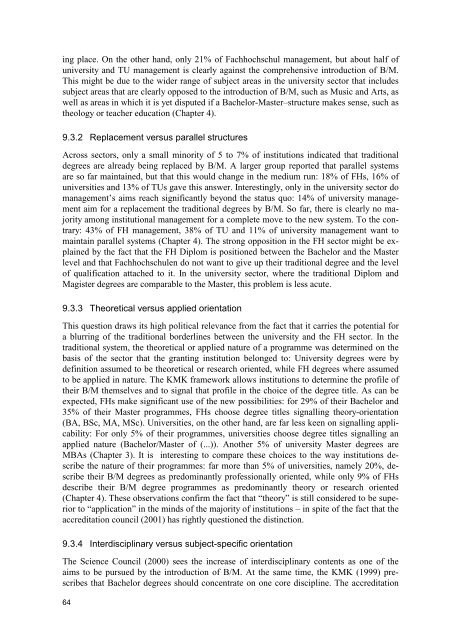and Master Programmes in German Higher Education Institutions
and Master Programmes in German Higher Education Institutions
and Master Programmes in German Higher Education Institutions
- No tags were found...
Create successful ePaper yourself
Turn your PDF publications into a flip-book with our unique Google optimized e-Paper software.
<strong>in</strong>g place. On the other h<strong>and</strong>, only 21% of Fachhochschul management, but about half ofuniversity <strong>and</strong> TU management is clearly aga<strong>in</strong>st the comprehensive <strong>in</strong>troduction of B/M.This might be due to the wider range of subject areas <strong>in</strong> the university sector that <strong>in</strong>cludessubject areas that are clearly opposed to the <strong>in</strong>troduction of B/M, such as Music <strong>and</strong> Arts, aswell as areas <strong>in</strong> which it is yet disputed if a Bachelor-<strong>Master</strong>–structure makes sense, such astheology or teacher education (Chapter 4).9.3.2 Replacement versus parallel structuresAcross sectors, only a small m<strong>in</strong>ority of 5 to 7% of <strong>in</strong>stitutions <strong>in</strong>dicated that traditionaldegrees are already be<strong>in</strong>g replaced by B/M. A larger group reported that parallel systemsare so far ma<strong>in</strong>ta<strong>in</strong>ed, but that this would change <strong>in</strong> the medium run: 18% of FHs, 16% ofuniversities <strong>and</strong> 13% of TUs gave this answer. Interest<strong>in</strong>gly, only <strong>in</strong> the university sector domanagement’s aims reach significantly beyond the status quo: 14% of university managementaim for a replacement the traditional degrees by B/M. So far, there is clearly no majorityamong <strong>in</strong>stitutional management for a complete move to the new system. To the contrary:43% of FH management, 38% of TU <strong>and</strong> 11% of university management want toma<strong>in</strong>ta<strong>in</strong> parallel systems (Chapter 4). The strong opposition <strong>in</strong> the FH sector might be expla<strong>in</strong>edby the fact that the FH Diplom is positioned between the Bachelor <strong>and</strong> the <strong>Master</strong>level <strong>and</strong> that Fachhochschulen do not want to give up their traditional degree <strong>and</strong> the levelof qualification attached to it. In the university sector, where the traditional Diplom <strong>and</strong>Magister degrees are comparable to the <strong>Master</strong>, this problem is less acute.9.3.3 Theoretical versus applied orientationThis question draws its high political relevance from the fact that it carries the potential fora blurr<strong>in</strong>g of the traditional borderl<strong>in</strong>es between the university <strong>and</strong> the FH sector. In thetraditional system, the theoretical or applied nature of a programme was determ<strong>in</strong>ed on thebasis of the sector that the grant<strong>in</strong>g <strong>in</strong>stitution belonged to: University degrees were bydef<strong>in</strong>ition assumed to be theoretical or research oriented, while FH degrees where assumedto be applied <strong>in</strong> nature. The KMK framework allows <strong>in</strong>stitutions to determ<strong>in</strong>e the profile oftheir B/M themselves <strong>and</strong> to signal that profile <strong>in</strong> the choice of the degree title. As can beexpected, FHs make significant use of the new possibilities: for 29% of their Bachelor <strong>and</strong>35% of their <strong>Master</strong> programmes, FHs choose degree titles signall<strong>in</strong>g theory-orientation(BA, BSc, MA, MSc). Universities, on the other h<strong>and</strong>, are far less keen on signall<strong>in</strong>g applicability:For only 5% of their programmes, universities choose degree titles signall<strong>in</strong>g anapplied nature (Bachelor/<strong>Master</strong> of (...)). Another 5% of university <strong>Master</strong> degrees areMBAs (Chapter 3). It is <strong>in</strong>terest<strong>in</strong>g to compare these choices to the way <strong>in</strong>stitutions describethe nature of their programmes: far more than 5% of universities, namely 20%, describetheir B/M degrees as predom<strong>in</strong>antly professionally oriented, while only 9% of FHsdescribe their B/M degree programmes as predom<strong>in</strong>antly theory or research oriented(Chapter 4). These observations confirm the fact that “theory” is still considered to be superiorto “application” <strong>in</strong> the m<strong>in</strong>ds of the majority of <strong>in</strong>stitutions – <strong>in</strong> spite of the fact that theaccreditation council (2001) has rightly questioned the dist<strong>in</strong>ction.9.3.4 Interdiscipl<strong>in</strong>ary versus subject-specific orientationThe Science Council (2000) sees the <strong>in</strong>crease of <strong>in</strong>terdiscipl<strong>in</strong>ary contents as one of theaims to be pursued by the <strong>in</strong>troduction of B/M. At the same time, the KMK (1999) prescribesthat Bachelor degrees should concentrate on one core discipl<strong>in</strong>e. The accreditation64
















